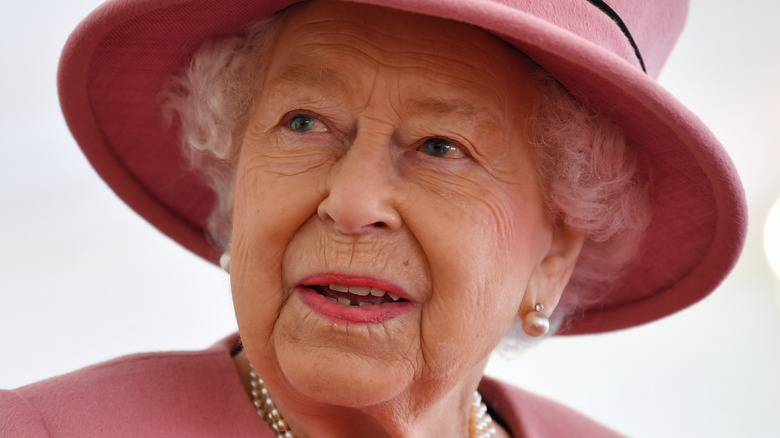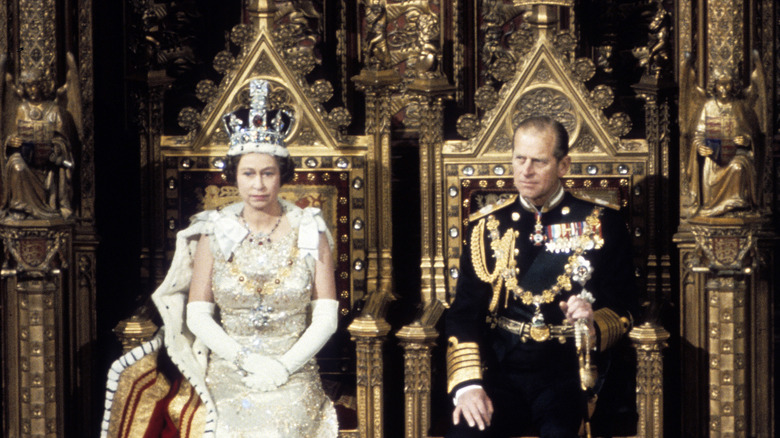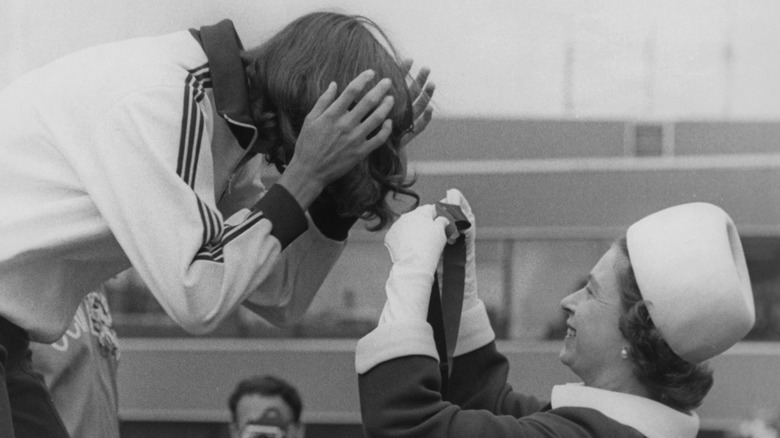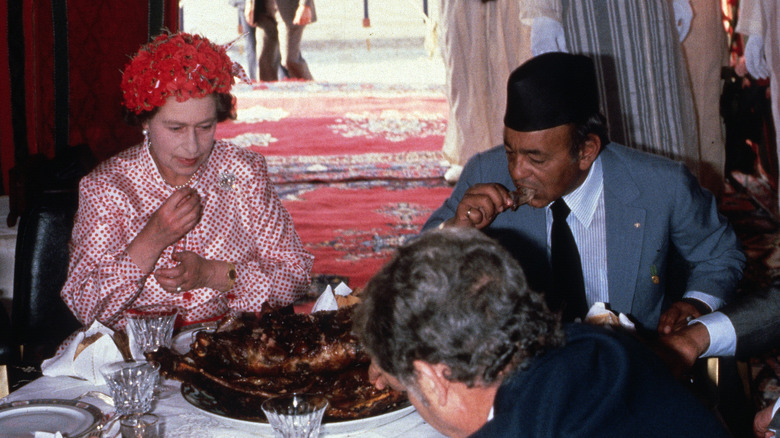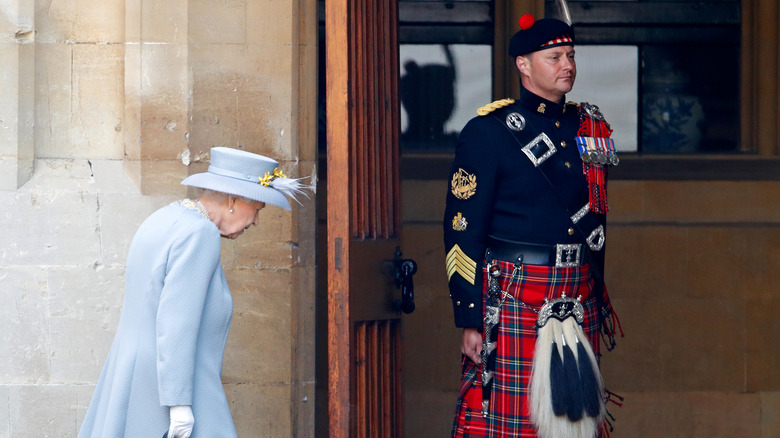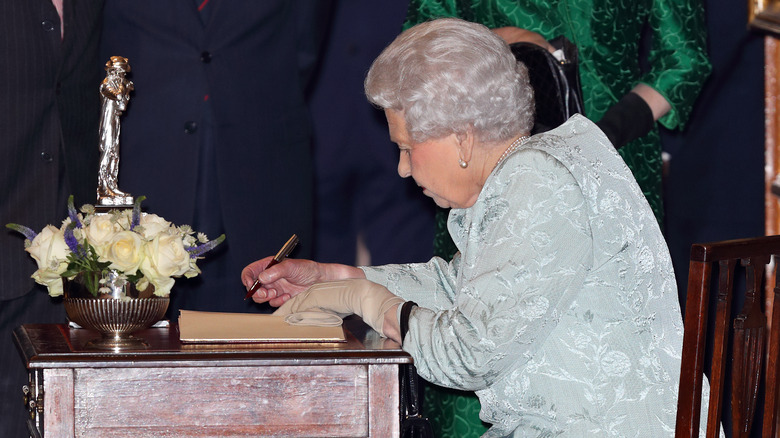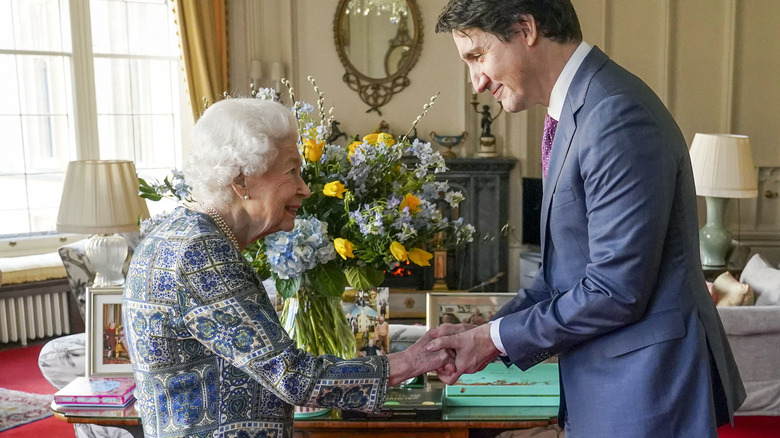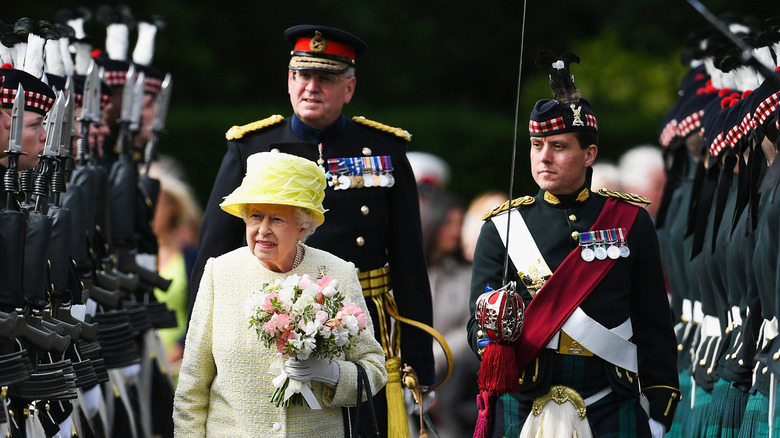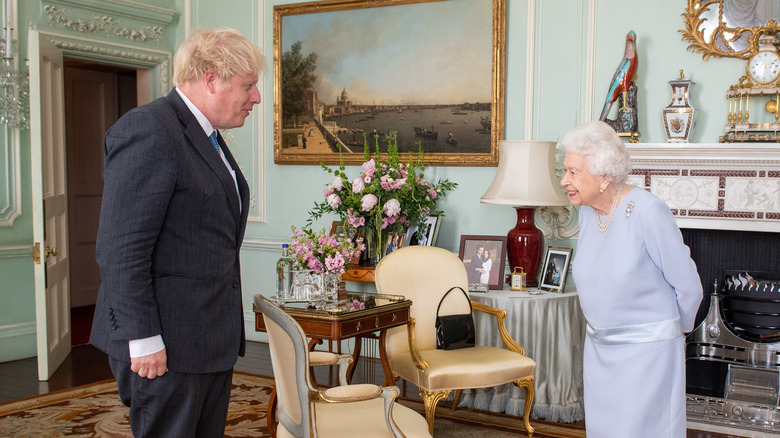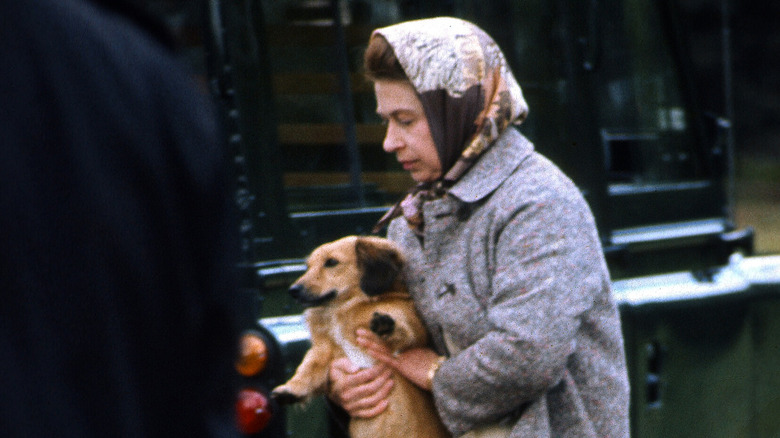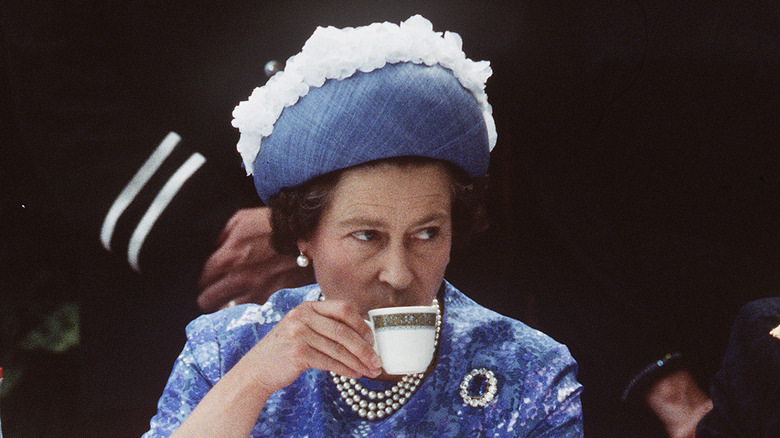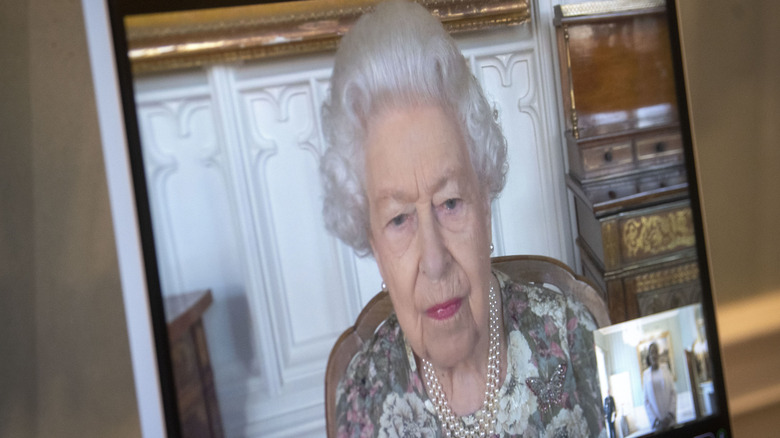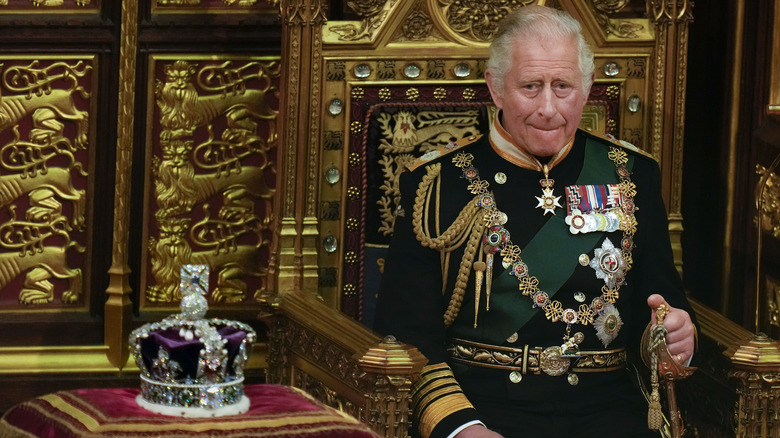What Queen Elizabeth's Daily Routine Is Really Like
Heavy is the head that wears the crown, they say. As a metaphor for weighty responsibilities, it may not be quite as pertinent to the members of Britain's royal family today. None of them play an active role in government, not even the reigning sovereign, Queen Elizabeth II. She's been obligated to slow down in the role she does play for the past few years, being 96 years old as of 2022. According to ABC News, her working days in 2019 came to 67, if the count is limited to official public functions.
There is more to reigning as sovereign than those hours counted by the Court Circular, however. Every day of the year for the past 70 years (excepting Christmas and Easter Sunday, per Hello!), the queen has tended to something related to her position. 70 years spent on any job would lead to almost anyone developing a routine to manage, and the queen is no exception. Let's take a look at what goes into the day-to-day business of a constitutional monarch – and what changes age and the pandemic have brought to the queen's daily schedule.
Routines Within Limits
Just what Queen Elizabeth is obliged and offered to do is dictated by the role the monarchy plays in modern British life. The United Kingdom is a constitutional monarchy, with the powers and responsibilities of the head of state (the monarch) separated from those of the head of government (the prime minister). The BBC describes the queen's role as "strictly symbolic and ceremonial." She takes no part in politics and remains a neutral presence. The royal family's own website, Royal.uk, acknowledges that, by convention, the queen can't even vote.
Possibly the most elaborate ceremonial function the queen performs is the annual State Opening and Queen's Speech, delivered at the beginning of every Parliamentary year from the House of Lords. Her other duties related to Parliament as head of state involve formally appointing a new government (the choice dictated by the winner of a general election), formally dissolving a government ahead of a new election, and granting Royal Assent to legislation.
With Wales, Scotland, and Northern Ireland all having devolved parliaments, the queen performs ceremonial duties for them as well. Royal.uk makes a distinction between these official functions of the head of state and the monarch's role as "head of nation," a less prescribed position as a champion of service, the fount of recognition for outstanding performance, and as a point of stability, continuity, and national unity for the UK. Her daily work encompasses both roles.
Early to Rise
According to the Daily Mail, Queen Elizabeth's day begins at 7:30 a.m. That's when the overnight guard (the Royal Sergeant) steps down and the maid takes over. The maid brings with her tea (Twinings Earl Grey) and biscuits. (For the non-British, it seems the correct way to make tea, royal or commoner, is to add the milk before the hot water, per the Guardian). As the queen enjoys this properly made tea to the sound of BBC Radio 4's "Today," the maid draws a bath. Allegedly, the bath must be exactly seven inches of water for an 8 a.m. wash.
After her morning bath, the queen dresses. Her wardrobe is managed by her personal assistant Angela Kelly, with one of three aides lending a hand. Twice a week, according to the Daily Record, the queen then sits down for her hair appointment. The symmetrical hairstyle she wears hasn't changed in decades and is the work of Scott Ian Carmichael of Stirling. Of course, while isolating during lockdown in 2020, visits from the hairdresser weren't possible. Kelly assumed the duties then, according to the Guardian.
A Royal (And Eccentric) Breakfast
Breakfast is served at 8:30 a.m. Contrary to media depictions of monarchs feasting over enormous bounties of food, Queen Elizabeth sets a lean table. Described by her former chef Darren McGrady as the sort of person who eats to live (per the Independent), the queen tends to stick to cereal and fruit every morning, Special K being the preferred cereal. On occasion, she may supplement or replace the usual with toast and marmalade, smoked salmon, or scrambled eggs, per the Telegraph.
While the fare may be simple, the queen's breakfast isn't without its oddities. According to the Guardian, all her Special K and other cereals are kept in Tupperware, in the belief that it keeps better there. Brown eggs are favored on the assumption that they taste better, and her chef provides a menu for every meal with three options, all written in French thanks to a tradition begun by Queen Victoria's chef.
Quirks around the breakfast table seem to run in the family. Victoria also favored simple dishes, but she ate her eggs with golden utensils. Edward VII included chicken and lobster with a full, cooked breakfast. Elizabeth's son Charles, Prince of Wales, was caught up in a minor fuss with writer Jeremy Paxman over whether or not the prince required seven soft-boiled eggs each morning to see if one met his standards (the prince insists not). French menus and judging flavor by shell color don't seem so odd in comparison.
Piper to the Sovereign
Many traditions of the British monarchy date to Queen Victoria's time, including matters of the monarch's daily schedule. According to Reader's Digest, after a sojourn up in Scotland with Prince Albert, Victoria became taken with the sound of bagpipes. She loved them so much that she resolved to have a piper with her even in England. Thus was born the title of Piper to the Sovereign. Every morning at 9 a.m., it is the piper's duty to stand below the monarch's window and play for 15 minutes. The job also involves playing music at dinner on certain occasions.
Queen Elizabeth is said to be just as fond of bagpipes as her great-great-grandmother. So great is her fondness for the instrument and the morning ritual that the Piper to the Sovereign travels with the queen to all but one of her residences within the United Kingdom. Sandringham House is the odd one out, being unable to accommodate a piper. The queen seems to have had a good relationship with her musicians, with 15th piper Scott Methven speaking publicly of her support for him (via the BBC). On the other hand, her tastes and expectations put a significant technical burden on whoever holds the job. Since the queen doesn't like having the same song repeated too often, according to former piper Gordon Webster (via WMUR-TV), it's necessary to have a large library of tunes committed to memory.
Copious Correspondence
Queen Elizabeth's working day properly begins at 9:30 a.m, when she turns to her daily delivery of correspondence for around two hours (per Victoria Howard of the Crown Chronicles). As head of state, the queen is among those who receive a daily red box, a despatch of official government documents. According to Barrow, Hepburn, and Gale, makers of the boxes, delivering messages to the sovereign in a designated case dates back to the reign of Elizabeth I, with the current red design in place for over a century. The color either originates from a coded message in blood pudding by Elizabeth I to the ambassador of Spain, or from Prince Albert's preference for red.
As a constitutional monarch, the queen's approval of government policy is a formality. According to the BBC, no monarch has refused to grant Royal Assent to legislation since 1708. Nevertheless, the queen reads through all the state papers she receives before granting her signature. The red box is the one state duty that the queen must tend to every day except for Christmas and Easter Sunday.
Besides matters of state, the queen's correspondence also includes letters addressed to her personally from the public, around 300 a day. Most of this is answered by a lady-in-waiting, with the manner of the replies dictated. But the queen does take time to answer a choice few personally, chosen at random.
20-Minute Meetings
At 11 a.m. Queen Elizabeth begins a series of audiences, one-on-one meetings of about 20 minutes each. According to Royal.uk, those granted an audience can include government officials, religious leaders, military personnel, and recipients of prestigious awards. The primary purpose of these late-morning meetings, however, is to talk with members of the diplomatic community. Any ambassador or High Commissioner (an ambassador from a Commonwealth nation) has an audience with the queen shortly after they begin the job, and with more than 170 ambassadors in London at a given time, there's no shortage of diplomats to receive.
When the queen is in residence at Buckingham Palace, ambassadors are brought to their audience in a horse-drawn carriage known as State landau, a custom dating back to Victorian times. Meetings are held either in State or semi-State rooms in the palace, with the queen's private quarters made use of on occasion. Approving the credentials of a new ambassador upon their appointment is among the queen's ceremonial duties.
According to Victoria Howard of The Crown Chronicles, these morning audiences are kept around the 20 minute mark to ensure no time is wasted and that only pertinent subjects are discussed. But just what the queen and her visitors say in any of these audiences will never be known for sure; they are kept as private conversations. No written, audio, or video record is maintained for any of them.
All About the Engagements
The bulk of Queen Elizabeth's workload comes from engagements. Described by the Independent as a "catch-all term," engagements are those appearances and duties performed by the queen at public and private functions around the United Kingdom and abroad. In her official capacity as head of state, these include, but are not limited to, the State Opening of Parliament, hosting visiting heads of state and government, diplomatic missions, the presentation of honors, and presiding over military ceremonies as Colonel-in-Chief. While the reigning sovereign is prescribed official duties, other members of the family can represent her when she cannot be physically present, as in the 2022 State Opening (per the Washington Post).
The queen and her family also act as patrons to over 3,000 charities, with the queen herself patron to 600 before she began passing some of her patronages on to other members of her family (per Royal.uk). Besides offering financial support, the royal family will attend engagements on behalf of these charities throughout the year.
Royal.uk puts the number of engagements the royal family carry out per year at 2,000. According to Bustle, on days where the queen is away from home, the time she would spend in the mornings on personal audiences is given over to engagements as well. Even when she is at home, there will be times when an engagement will take precedence – for instance, a formal ceremony for the investiture of titles.
Meeting with the Prime Minister
Though the monarchy of Britain has long since given up a role as the head of government, the reigning sovereign and the prime minister keep in regular contact. Every Wednesday, according to Royal.uk, Queen Elizabeth will meet with her current prime minister (US Magazine has the time down at 6:30 p.m.). The meetings are typically held in Buckingham Palace (per BBC Newsround), though phone calls will suffice in the event of travel, or a lockdown in response to a global pandemic.
The queen has had 14 prime ministers over her 70-year reign. While she theoretically appoints and dismisses the prime minister at her discretion, no monarch has defied the majority will of Parliament since 1834 (per Liberal History). Their meetings, like her morning audiences with the diplomatic corps, are private conversations without any record kept. Former PM Harold Wilson once quipped that they were the only meetings he was confident would stay confidential.
It may be tempting to imagine that these weekly meetings are an anachronistic formaily, with the monarch so divorced from governance. But former PMs David Cameron and John Major both spoke of the value they found in the meetings and in the queen's ready knowledge of current events. Elizabeth herself once volunteered her perspective: "They tell me what is going on or if they have any problems, and sometimes I can help in some small way as well. They know I can be impartial and it is rather nice to feel one is a sponge."
Family Matters
While the role of monarch demands a considerable portion of Queen Elizabeth's working day, she has additional duties in her private life. According to Victoria Howard of The Crown Chronicles, the queen is responsible for the administration of her private states of Balmoral (the summer retreat) and Sandringham (the winter house). She has spoken warmly of Sandringham as a family home in the 1992 BBC documentary "Elizabeth R: A Year in the Life of a Queen," but insisted that it was also a viable farm, and that she felt responsible to those who lived and worked the estate. Until his death in 2021, Prince Philip, Duke of Edinburgh, was also involved in administering the estates.
The queen, by her own account in "Elizabeth R," also takes personal responsibility for the stud farm at Sandringham. Thoroughbred racehorses from her stables compete in several British horse races. They've been known to win, though the queen conceded that the stud isn't a profitable enterprise. It's fueled by love for horses and the gambler's instinct that victory will come eventually.
Horses aren't the only animals the queen tends to personally. While she reportedly stopped breeding her famous corgi dogs in 2018 (via the Telegraph), she tends to her canine companions' needs herself and travels with them when she can. Her less-famous labradors stay at Sandringham.
Visits from human family are welcome. However, when one is Queen of the United Kingdom, even family need to book time in advance.
The Wind-Down
On a typical working day, according to Victoria Howard of The Crown Chronicles, Queen Elizabeth will catch a light break for afternoon tea at 4 p.m., with scones and sandwiches for a recharge. But there is more work to be done after tea. After the morning's delivery of the red box, another official report arrives at 7:30, the record of the daily proceedings of Parliament. While reading over the report, the queen may indulge in a drink. Her favorite is a Dubonnet cocktail with gin in a 2 to 1 ratio.
If there are no more affairs to be tended to in a day, the queen takes her dinner privately, usually from a menu sourced from the royal stocks. Former chef Darren McGrady reports (via the Telegraph) that starch is left off the table as a rule, while options for a main course include salmon, pheasant, or venison. If there is a reception, however – for a visiting dignitary, or to launch an overseas visit – then dinner becomes another engagement for the day.
When there isn't a reception to host, the queen retires at 9 p.m. Sometimes she'll sit up to read, and sometimes she'll take in a bit of television. "Downton Abbey" was apparently a favorite (as was spotting any inaccuracies). Bedtime, according to Finty, is 11 p.m.
2020 Changes
2020 and the COVID-19 pandemic disrupted everyone's routine, and Queen Elizabeth was no exception. The United Kingdom instituted several lockdowns in response to the coronavirus (via the Institute for Government), which curtailed the sort of in-person audiences and engagements that make up so much of the queen's working life. With self-isolation encouraged, the queen and Prince Philip removed themselves to Windsor Castle, according to People. Dogs and horses provided some comfort, as did attending Windsor's private chapel. The queen and Philip were early beneficiaries of the COVD vaccine.
Lockdown didn't prevent the queen from working, however. She continued to receive her red box of government papers every day. Her audiences and her meetings with her charities continued as well thanks to video conferencing. But even Queen Elizabeth II couldn't resist relaxing her schedule just a little bit; since COVID, her 7:30 wake-up call falls a little later in the morning.
The Long Transition
As the pandemic recedes, some matters of life may return to normal, while others are permanently altered. For several years prior to the pandemic, according to the Guardian, the royal family has been slowly and quietly carrying out "Operation Transition" ahead of Queen Elizabeth's eventual death and the ascension of Prince Charles. The pandemic in some ways accelerated the process.
Lockdown curbed the queen's usual itinerary, but even as movement restrictions have been lifted, she has not resumed her usual slate of duties. She came down with COVID-19 herself early in 2022 (per the Guardian) and has since suffered "episode mobility issues" in the phrasing of Buckingham Palace. In her capacity as head of state, this hasn't mattered much. Other than the State Opening of Parliament in 2022, which she entrusted to Charles, she is still able to carry on with such duties as reading and approving government policy and conducting audiences with diplomats and ministers, mostly virtually.
In her less formal role as head of nation, however, the queen has become much less active and is likely to further cede responsibility to the royal family (also per the Guardian). Charity patronages, military inspections, even the investiture of titles have been increasingly taken over by Charles and Prince William.
